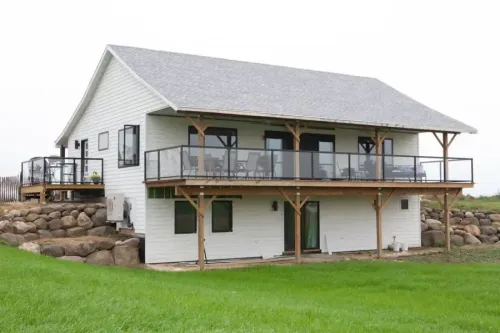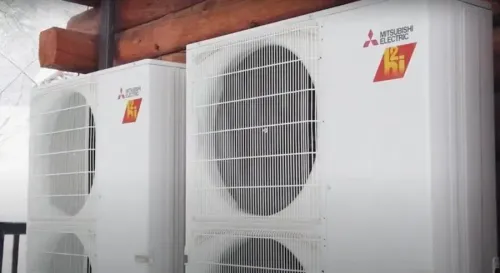Challenge: Replacing the conventional HVAC system to improve occupant comfort, decrease energy cost, and reduce its carbon footprint.
Solution: A ductless, water-source Hybrid Variable Refrigerant Flow (VRF) heat pump system and a ductless water-source VRF solution from Mitsubishi Electric.
Watch the Video: https://bit.ly/42N3Yld
Weber State University is creating an environmentally friendly, energy-conscious campus that simultaneously serves as a living laboratory for students in its engineering and environmental programs. The school's environmental goals include electrification by eliminating conventional, natural gas-fired, and less efficient HVAC systems. So far, about half of the campus' HVAC systems are fully electric.
Historically, Weber State University's buildings have been cooled with chilled water from a central water plant and heated with steam from a central steam plant, neither of which are energy-efficient compared to modern systems. Today, many of its buildings have been retrofitted with all-electric, all-climate, water-source heat pump solutions. Moving forward, the university plans to convert the entire campus to Mitsubishi Electric Hybrid Variable Refrigerant Flow (VRF) solutions. Hybrid VRF systems use water instead of refrigerant indoors and are a key technology in the movement to electrify and decarbonize buildings.
"We're also creating an energy recovery network for our entire campus, with all buildings connected to the same water loop," said Justin Owen, Interim Director of Operations for Weber State University.
"The Mitsubishi Electric heat pumps connected to that water loop enable us to save money on our electricity bills and reinvest those savings into renewable solutions like solar, which allows us to source that electricity renewably," he said.
Learning About All-Climate Heat Pumps
In 2015, Weber State University started installing water-source VRF systems. For instance, the university has a ductless, water-source VRF heat pump system from Mitsubishi Electric in its Noorda Engineering building. The Noorda Engineering building is home to the university's electrical engineering, mechanical engineering, and energy engineering programs. Most parts of the VRF solution are on display to students, labeled and exposed - from the condenser to the branch controller to the fan coils - enabling them to learn and work with all-climate heat pump technology.


University personnel attending a trade show in Las Vegas were introduced to the Mitsubishi Electric Hybrid VRF solution by their HVAC distributor, Applied Product Solutions, located in south Salt Lake City. In 2024, Weber State installed its first water-source, Hybrid VRF solution in its six-level SkySuites, an addition to Stewart Stadium. The SkySuites house the Weber State Athletics Department, coaching staff offices, a press box, 26 suites, 150 club seats, and a study area for student-athletes.
"One thing that I've been really impressed with regarding the Mitsubishi Electric hybrid system is that it uses less refrigerant than a more conventional system, which is really important to us, especially with the coming changes to new low GWP refrigerants," said Brad Lash, P.E., Vice President, WHW Engineering.
Enjoying the Benefits of VRF and Hybrid VRF
An advantage of VRF and Hybrid VRF technology is improved comfort and efficiency provided by zoning. With zoning, each room has its own thermostat, giving occupants control to heat or cool their space to their comfort level.
"At our homecoming football game, I stopped by our presidential suite because historically, the SkySuites' temperature was hard to manage, said Owen. "When i asked President Mortensen about the temperature, he said, 'It's been great. It's normally hot in here, but I'm comfortable.'"
Weber State University also benefits from Mitsubishi Electric smart energy controllers that come with a light-level sensor and an occupancy sensor. These energy-saving features enable staff to remotely control temperatures and adjust thermostats in unoccupied rooms to save on energy bills.
"Mitsubishi Electric Hybrid VRF consumes a lot less energy than our conventional systems," said Owen. "Whenever we do a retrofit, I run some energy numbers on what we consumed before and what we consume now. Mitsubishi Electric systems allow us to decrease our energy footprint by about 70% to 80%."
Plus, VRF and Hybrid VRF solutions are easy to perform routine maintenance on, according to Sean Dorsey, Service Advisor, Applied Product Solutions. Weber State chose to use mostly four-way ceiling cassettes in the SkySuites because these indoor units have easily removable air filters at the ceiling level.
"We provide a complete set of filters for every indoor unit," Dorsey said. "When they do maintenance, they take out the filter, place a new one, and wash the dirty ones so they're ready for the next time."
Creating a New Standard
Hybrid VRF solutions are perfect for retrofit projects like Weber State University's conversion from conventional HVAC systems to more modern technology. The Mitsubishi Electric ductless Hybrid VRF solution installation in the SkySuites took just eight months from start to finish. Another benefit of a ductless system was that it was easier to run piping instead of ducts through the SkySuites' tight ceiling space.
Since Weber State University is committed to reach carbon neutrality by 2040 and reduce the environmental impact of all operations, Mitsubishi Electric Hybrid VRF solutions enable the campus to meet its energy-conscious goals. In fact, its sustainability initiatives are a leading example for other universities prioritizing reducing their carbon footprint.
"Hybrid VRF is now our standard," Owen said. "We have three projects in design right now that will also be Hybrid VRF, and our plan is to convert the rest of the campus to hybrid." Owen stated that the positive environmental impact, reduced energy cost, and the overall lifecycle cost of the systems have impressed him.
In fact, he said Weber State University is sold on the Mitsubishi Electric brand exclusively because of the company's high-performing all-climate heat pump products, functionality, energy recovery, easy-to-use thermostats, intuitive control systems, local HVAC support, and warranties.
Project Team
Distributor: Applied Product Solutions
Skysuites Engineering Consultant: WHW Engineering
Skysuites Installing Contractor: Utah Engineering
Installed at the Noorda Engineering Building
- (237) SmartME Controllers
- (9) Central Controllers
- (13) PQRY Water-source Units
- (5) PQHY Water-source Units
- (28) BC Controllers
- (10) PKFY Wall-mounted Indoor Units
- (48) PEFY Ceiling-concealed Ducted Units
- (228) PLFY Ceiling-recessed Cassettes
- (6) LEV Kits
Installed at SkySuites
- (187) SmartME Controllers
- (12) PQRY Water-source VRF Systems
- (1) PURY Air-source VRF Systems
- (21) Main Hybrid Branch Circuit Controllers
- (10) PKFY Hybrid Wall-mounted Indoor Units
- (153) PLFY Hybrid Ceiling Cassette Indoor Units
- (1) PEFY Hybrid Ceiling-concealed Ducted Unites
- (2) AE-200A Central Controllers
- (5) EW-50A Expansion Controllers









